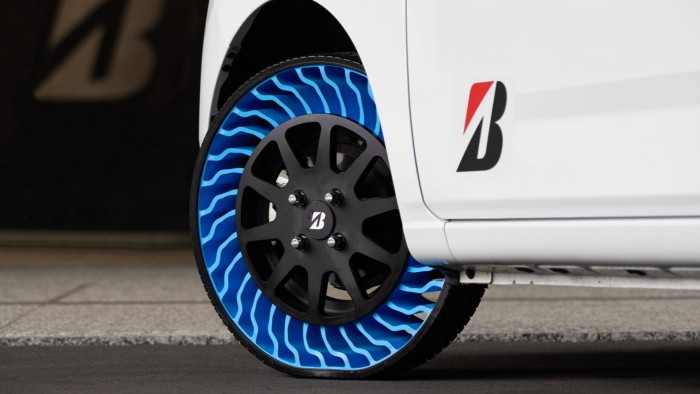Physical Address
304 North Cardinal St.
Dorchester Center, MA 02124
Physical Address
304 North Cardinal St.
Dorchester Center, MA 02124

Unlock Digest Editor FREE
Roula Khalaf, FT editor, chooses his favorite stories in this week bulletin.
The Bridgestone auto parts provider test progress in tires that never break, potentially smoothing the way for multiple vehicles for independent ride.
Japanese company seen in France Michelin to be the world’s largest tire supplier, developed a version without air that it can support the 1-tone of vehicles that runs in 60 km, and a decade ago.
The new constructions and materials with a computer led to significant innovations at higher speeds and weights, making the candidators replace the pneumatic tires just as driver without drivers place the premium of safety and without stopping.
But huge performance and cost of pneumatic tires make them extremely difficult for deviation.
The new tires are abolished on the shuttle bus and tourist cars, because Japan wants to bring autonomous ride in the rural community to solve the shortages of drivers and mechanics. Innovation is also seen as a potential differenterial in the middle of the rising Chinese and Indian competition.
“When we eventually get to autonomous driving, it will be a great value in avoiding vehicles without drivers without drivers for shooting the tire,” Masaka OTA, director of Bridgestone’s business mobility.
Computer simulations helped create tires with a winding tread in a rubber tread, with volumes that can bounce and bend greater speed and weight, without becoming a retransmission, smooth ride and safety compared to previous air-free rubbers.

The tires could mean lower maintenance costs and reduced risk of responsibility than autonomous traffic accidents caused by breakthroughs.
But experts are afraid of design, and production costs several times from pumping tires could be struggled to cut out to Nis. Bridgestone also reversed the usual logic of innovation, targeting the first will with low performance for the mass market, instead of testing high-performance products.
The replacement of all pneumatic tires without a plane is “utopia that will cost too much,” said Florent Menegaux, director Michelin. The company has worked on air-free tires for 20 years and has already placed their version, called small vehicles such as lawn mowers.
“I’m going to the mower to the car, to drive in 50 km per hour, presents other problems,” he said. They include vitring sound, the risk of stones flying from the volume and maintaining performance at high speeds and weights, analysts said.
Michelin initiated trials to his breakthrough, without air Upto tires on small vans for DHL and LA Shipping Groups, but rubber and aluminum wheels remain in the prototype phase.
Menegaux said that Michelin “was not ready from the industrial point of view” to add it further, despite logistics groups “Very happy”.
Bridgestone hopes to carry customer readiness to pay airless tires through demonstrations, like a six-sea car ride in a mountain part of Higashioma in which they are older than half 309 inhabitants.
“We honestly haven’t achieved a clear vision of how much this job will do and what the market will be,” said OTA. “But we’re not waiting to find out.”
The incentive for the main current tyremakers is convincing. Their business model is under threat from cheaper Chinese and Indian competition, while tires became molded, and they lose about 5 percent a year of total quantity, cites the tire industry, specialist counseling.
Instead, tire suppliers want to expand in services. Customers would return regularly to return air-free tires – it is expected to last 10 years versus three to five for pneumatic tires.
“I still don’t know if it will work in terms of providing all the technical requirements of the Life and Fuel Savings and the price that the world needs,” David Shaw, director of the tire industry.
But success is more likely than not, he added, because “pneumatic tires hurt.”